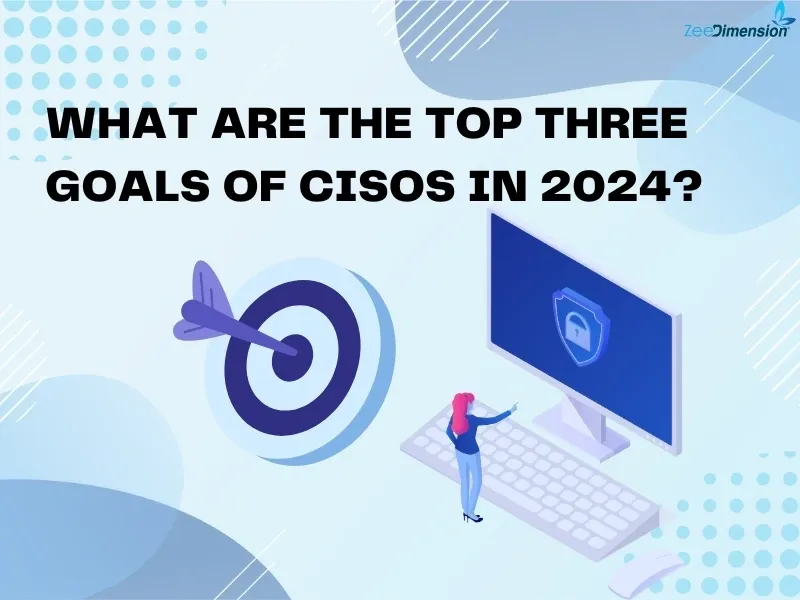
In today’s evolving cyber landscape, CISOs confront increasing challenges due to the sophistication of cyber threats and the tightening of regulations. CISOs must prioritize facilitating business growth through security in addition to network defense because organizations are becoming increasingly dependent on digital operations. A CISO’s responsibilities now extend beyond threat mitigation to include managing risks related to emerging technologies like artificial intelligence, coordinating security strategies with overarching business objectives, and guaranteeing compliance with ever-tougher regulatory requirements. These changing dynamics are reflected in the top objectives of CISOs in 2024, according to the Proofpoint “Voice of the CISO” report. Let’s explore the top three goals of Chief Information Security Officers in 2024, based on the latest insights from the Proofpoint “Voice of the CISO” report.
📷
1. Protecting Against Ransomware and Cyber Attacks
Ransomware is a major concern for 41% of CISOs, prompting organizations to prioritize cyberattack defense. Advanced security solutions like EDR, threat intelligence platforms, and robust incident response protocols are being used to detect, analyze, and respond to potential threats. Ransomware defense strategies often involve data backups, network segmentation, and zero-trust architectures. In addition to technical defenses, CISOs are enhancing employee awareness training to combat ransomware attacks, focusing on phishing and social engineering attacks. This combination of technological solutions and human vigilance can significantly reduce organizations’ risk of falling victim to these costly attacks.
-
Securing Cloud and Remote Work:
CISOs are focusing on securing endpoints and accounts to minimize vulnerabilities in remote work environments. They are implementing zero-trust network models, multi-factor authentication, and identity access management solutions to reduce the attack surface. moreover, cloud security is crucial as businesses migrate to cloud platforms. CISOs use cloud-native tools like CASBs and SASE to monitor and protect cloud environments, preventing data breaches and reducing the attack surface in 2024.
2. Mitigating Human-Centric Risks
74% of CISOs identify human error as their organization’s biggest vulnerability, prompting a focus on employee awareness and accountability. To mitigate risks, organizations invest heavily in cybersecurity training programs, ensuring staff can recognize and respond to potential threats. Phishing simulations are gaining popularity as a way for companies to test employees in a controlled environment, allowing them to learn from mistakes without causing harm. Regular simulations help CISOs assess training effectiveness and identify individuals needing further education. Insider threat detection systems are also crucial. In 2024, minimizing vulnerabilities requires consistent education, proactive monitoring, and cultivating a security-first culture to reduce human error.
-
Building a Security-First Culture:
CISOs are integrating cybersecurity into onboarding processes, performance evaluations, and regular communication channels to create a security-first culture in organizations. This approach reduces human error and insider threats, ensuring security becomes a core responsibility across all departments, not just IT. Cross-functional approach to security involves awareness campaigns, training, gamified learning tools, HR partnerships, and leadership involvement to create a secure environment for employees.
3. Strengthening Data Protection and Governance
The focus on data protection and governance is prompted by the fact that nearly half of CISOs report data loss. To monitor and prevent the transfer of sensitive information, organizations are putting advanced security solutions—such as Data Loss Prevention (DLP) tools—in place to make sure that private information is shielded from accidental exposure and unauthorized access. Data protection requires encryption, which renders data unreadable without a key. Cloud security solutions are being implemented to monitor and secure data stored in the cloud as businesses depend more and more on cloud services. Additionally, to minimize the risks associated with data breaches and ensure compliance with privacy regulations such as the CCPA and GDPR, CISOs are improving data governance frameworks to establish clear policies for data handling, storage, and access.
-
Compliance and Access Control:
CISOs are using machine learning and advanced analytics in addition to these tools to improve their data governance plans. These technological advancements aid in anticipating possible dangers and automating responses to compliance-related problems. Using real-time monitoring systems in conjunction with IAM and Zero Trust models, organizations can better manage user permissions and identify unusual activity that might point to a breach. This proactive approach strengthens the organization’s overall security posture and aids in regulatory compliance while protecting sensitive data from ever-evolving cyber threats.
Conclusion: Focus Areas for CISOs
To effectively address these challenges, CISOs are implementing a comprehensive strategy that involves investing in advanced security technologies, fostering a cybersecurity culture, and enhancing departmental collaboration. They are prioritizing the creation of robust incident response plans and conducting regular security training for their employees. CISOs integrate practices into their security strategy to create a resilient defense mechanism, adapting to threats and regulatory changes, requiring technological innovation and a thorough understanding of human and organizational security risks. CISOs are enhancing their organizations’ preparedness for cyber incidents, thereby safeguarding digital assets and preserving stakeholder trust.
Ready to Stay Ahead of Cyber Threats?
Connect with industry leaders and explore advanced security solutions to protect your organization against evolving cyber threats in 2024.







